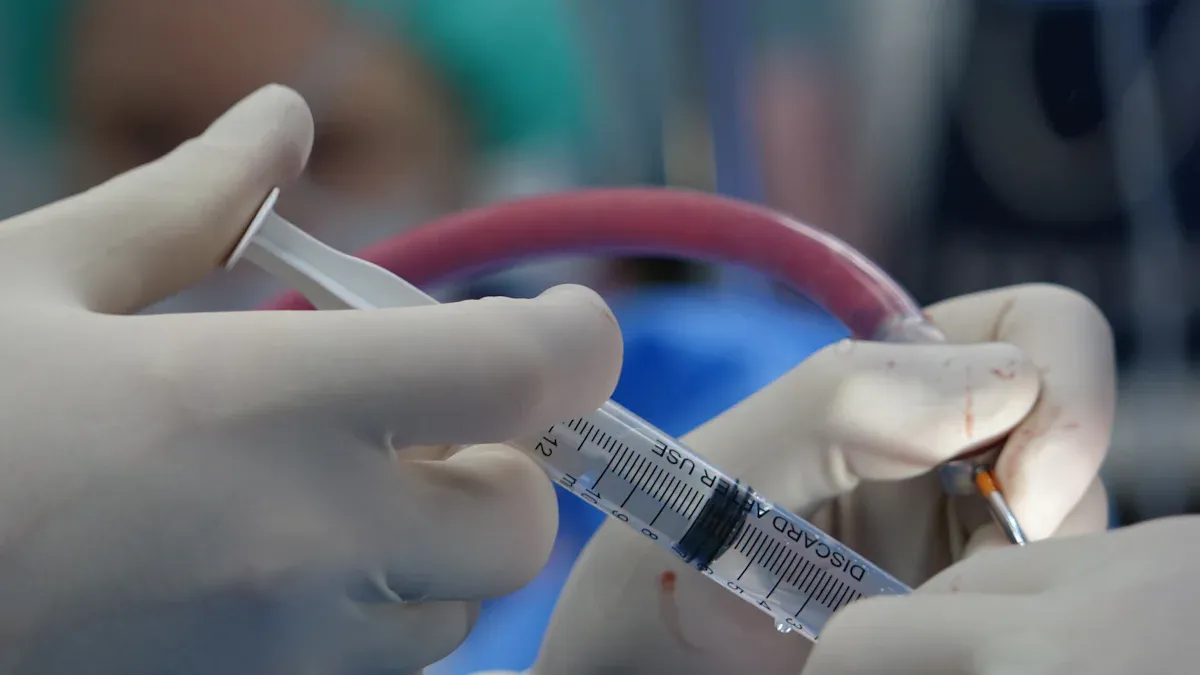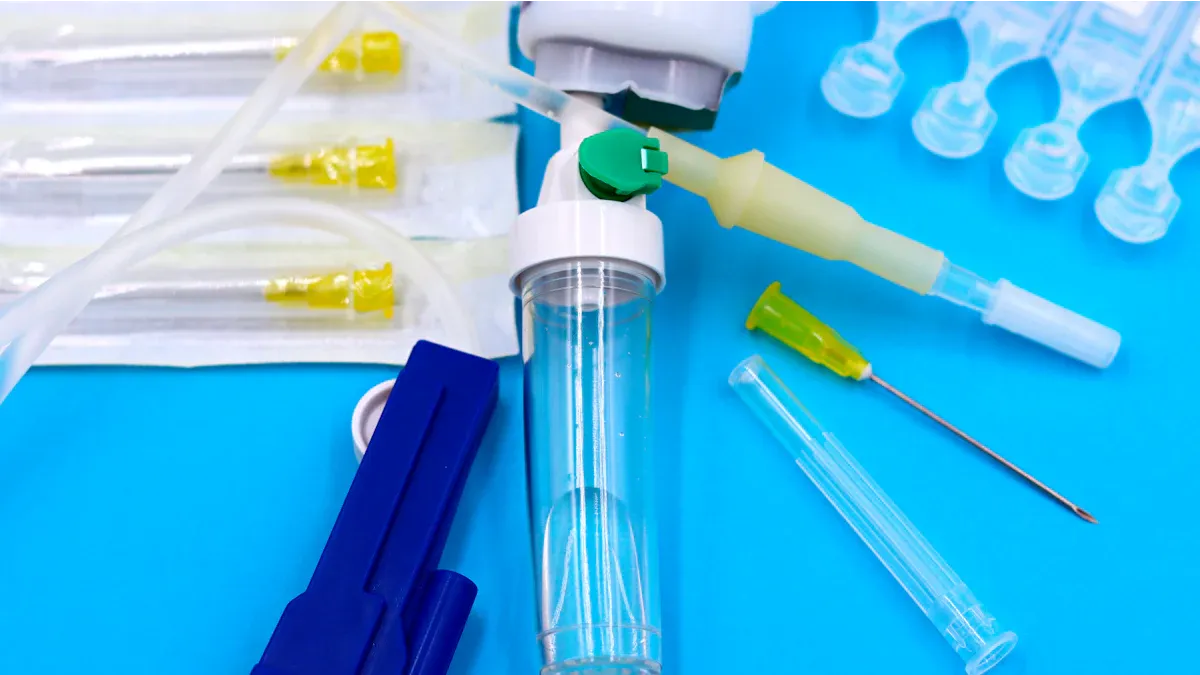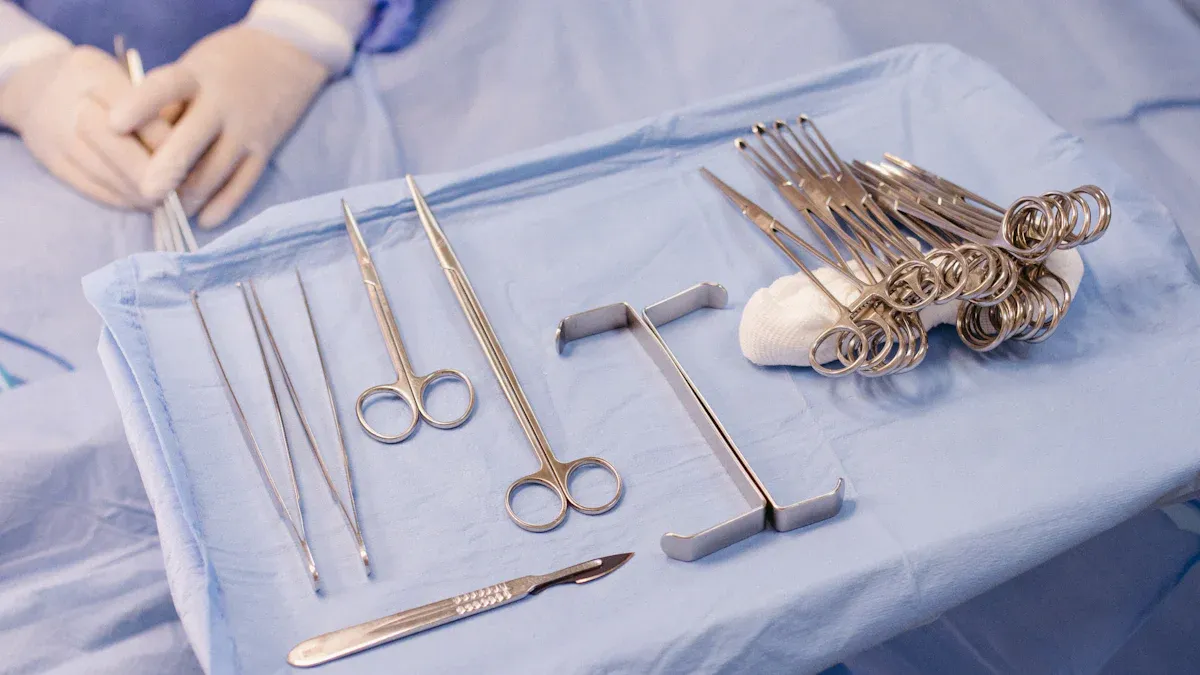The Role of PEEK Catheter Tubing in Advanced Surgical Techniques

PEEK catheter tubing serves as a high-performance polymer essential for minimally invasive surgery. Its exceptional mechanical properties meet the rigorous demands of modern medical applications. Surgeons rely on its high thermal stability to maintain performance during procedures. Its chemical resistance ensures safety and durability within the body. Additionally, the radiolucent nature of PEEK improves postoperative imaging. With a modulus of elasticity similar to bone, it reduces stress shielding and supports natural bone growth. These qualities make PEEK catheter tubing for minimally invasive surgery a cornerstone of precision, durability, and reliability in advanced techniques.
Key Takeaways
PEEK tubing is important for small surgery because it is strong.
Its smooth surface helps doctors work carefully and avoid hurting tissues.
PEEK can handle high heat, making it good for hot surgeries like laser use.
It resists chemicals, staying safe and strong after being cleaned many times.
PEEK tubing can be customized to fit different surgeries, helping patients and doctors.
What Is PEEK Catheter Tubing for Minimally Invasive Surgery?

Overview of PEEK as a High-Performance Polymer
Polyether ether ketone, commonly known as PEEK, is a high-performance polymer that has revolutionized the medical field. Its unique combination of properties makes it an ideal material for minimally invasive devices, particularly catheter tubing. PEEK exhibits exceptional biocompatibility, ensuring it meets stringent medical standards for use within the human body. Its flexural modulus closely mimics that of cortical bone, providing the rigidity required for implanted applications without compromising patient comfort.
PEEK also stands out for its resistance to sterilization methods. It retains its mechanical and chemical properties even after exposure to autoclaving, gamma radiation, or ethylene oxide gas. This durability ensures that PEEK catheter tubing for minimally invasive surgery remains reliable across multiple uses. Furthermore, its radiolucency allows for clear imaging during procedures, aiding surgeons in achieving precision.
Key properties of PEEK include:
Biocompatibility for safe medical use.
Resistance to harsh sterilization processes.
Radiolucency for improved imaging.
Compatibility with additives to enhance specific characteristics.
These attributes make PEEK a cornerstone material in advanced surgical techniques, offering unmatched performance compared to traditional polymers.
Key Features of PEEK Tubing in Medical Applications
PEEK catheter tubing for minimally invasive surgery offers several features that enhance its functionality in medical applications. Its high temperature resistance ensures stability during procedures that involve heat, such as laser ablation or cauterization. Additionally, its low friction surface minimizes resistance, allowing for smoother navigation through delicate tissues and blood vessels.
Clinical studies have demonstrated the effectiveness of PEEK in various medical applications. For example:
Study Title | Findings |
|---|---|
A novel surgical technique in transforaminal lumbar interbody fusion by the bone graft delivery device: evaluation of therapeutic... | The study evaluated the use of a PEEK interbody fusion cage in a novel surgical technique, demonstrating its effectiveness in spinal procedures. |
Radiological outcomes of PEEK rods in patients with lumbar degenerative diseases: A minimum 5-year follow-up | PEEK rods showed protective effects on degenerated intervertebral discs, with a low incidence of complications and favorable radiographic outcomes over a minimum 5-year follow-up. |
These findings highlight the versatility and reliability of PEEK in medical environments. Its chemical resistance further enhances its suitability for use in vascular devices, stent placement, and heart valve implantation. The material's ability to withstand harsh chemicals and sterilization processes ensures long-term durability and safety.
Advantages of PEEK Over Traditional Materials in Catheter Design
PEEK surpasses traditional materials in catheter design due to its superior mechanical and chemical properties. Unlike conventional polymers, PEEK offers high burst pressure, excellent biocompatibility, and resistance to wear and tear. These qualities make it a preferred choice for minimally invasive devices.
Property | PEEK | Traditional Materials |
|---|---|---|
Chemical Resistance | High | Moderate to Low |
Burst Pressure | High | Lower |
Biocompatibility | Excellent | Varies |
Sterilization Tolerance | Over 3000 cycles | Limited |
The table above illustrates how PEEK outperforms traditional materials in critical areas. Its ability to endure over 3,000 sterilization cycles ensures that medical devices remain functional and safe over extended periods. Additionally, PEEK's chemical resistance protects it from degradation when exposed to bodily fluids or cleaning agents.
PEEK catheter tubing for minimally invasive surgery also benefits from its adaptability. Manufacturers can customize its properties by blending it with additives, enhancing characteristics like radiopacity or flexibility. This versatility allows PEEK to meet the specific demands of advanced surgical techniques, making it an invaluable material in modern medicine.
High-Heat Performance of PEEK in Surgical Applications
Thermal Stability and Its Importance in Surgical Procedures
Thermal stability plays a critical role in surgical procedures, especially those involving high temperatures. Medical devices must maintain their structural integrity and mechanical performance under extreme conditions. PEEK tubing excels in this regard, offering unmatched thermal stability that ensures reliability during demanding surgeries.
The ability of PEEK to withstand high temperatures is essential for procedures requiring precision and durability. For instance, laser ablation and cauterization generate significant heat, which can compromise the performance of traditional materials. PEEK's high glass transition temperature and melting point allow it to endure these conditions without deformation or loss of functionality.
Property | Value |
|---|---|
Glass Transition Temperature | 143 °C (289 °F) |
Melting Point | 343 °C (662 °F) |
Useful Operating Temperature | Up to 250 °C (482 °F) |
High Temperature Performance | Up to 260 °C (500 °F) |
These metrics highlight PEEK's ability to maintain performance during high-temperature surgical procedures, making it a preferred choice for advanced medical applications.
How PEEK Tubing Withstands High Temperatures During Use
PEEK tubing's exceptional heat resistance stems from its unique molecular structure. Fully crystallized PEEK demonstrates remarkable thermal properties, as evidenced by differential scanning calorimetry (DSC) tests. These tests reveal no significant heat flow until the material reaches its melting point of 340°C, underscoring its ability to endure extreme temperatures.
The crystallinity of PEEK enhances its mechanical strength and thermal stability, making it ideal for surgical applications. Devices made from PEEK retain their precision and structural integrity even after repeated exposure to sterilization processes like autoclaving and steam sterilization. Unlike traditional polymers, PEEK does not degrade under these conditions, ensuring consistent performance during extended surgical procedures.
PEEK can withstand continuous service temperatures up to 260°C, demonstrating its excellent thermal stability.
PEEK sheets endure temperatures up to 250°C (482°F) without losing structural integrity, which is essential for medical devices requiring frequent sterilization.
The high thermal stability of PEEK is crucial in surgical environments where precision and mechanical strength are necessary after repeated sterilization processes.
Examples of Procedures Requiring High-Heat Performance
Several surgical procedures demand materials with high-heat performance, and PEEK tubing meets these requirements effectively. Laser ablation, a technique used to remove or destroy tissue, generates intense heat that can compromise traditional polymers. PEEK's ability to withstand temperatures up to 260°C ensures its reliability in such applications.
Cauterization, another heat-intensive procedure, benefits from PEEK's thermal stability. The material maintains its structural integrity, allowing surgeons to perform precise operations without equipment failure. Additionally, PEEK's low coefficient of friction enhances its performance in microbore catheter applications, where smooth navigation through vasculature is critical.
Property | PEEK | Other Materials |
|---|---|---|
Processing Temperature | ~700 °F | Standard thermoplastics |
Dimensional Stability | 465 °F to 500 °F | Lower than PEEK |
Melting Point | 644 °F | Varies |
Coefficient of Friction | ~0.35 | 0.1 to 0.2 (fluoropolymers) |
Performance in Microbore | Excellent | Requires thicker walls |
These attributes make PEEK tubing indispensable in advanced surgical techniques, ensuring precision, durability, and reliability under high-heat conditions.
Low Friction Properties of PEEK for Precision

Benefits of Low Friction in Minimally Invasive Surgery
Low friction is a critical property in minimally invasive surgery. It allows medical devices to glide smoothly through tissues and blood vessels, reducing the risk of damage. PEEK tubing excels in this area due to its naturally low coefficient of friction. This feature minimizes resistance during device insertion and navigation, ensuring precise control for surgeons. The smooth surface of PEEK also reduces the force required to maneuver catheters, enhancing patient safety and comfort.
Low friction materials like PEEK play a vital role in improving surgical outcomes by enabling smoother and more controlled procedures.
Enhanced Precision in Microbore Catheter Applications
Microbore catheters demand exceptional precision, especially in delicate procedures involving small blood vessels or intricate anatomical structures. PEEK tubing meets these requirements with its low friction properties. Its smooth surface ensures accurate placement and movement of the catheter, even in challenging environments. This precision is particularly valuable in applications such as neurovascular interventions, where even minor deviations can have significant consequences.
PEEK's ability to maintain its structural integrity under stress further enhances its performance in microbore applications. The material's consistent behavior ensures reliable results, making it a preferred choice for advanced surgical techniques.
Reduction of Wear and Tear During Surgical Use
Repeated use of medical devices can lead to wear and tear, compromising their performance and safety. PEEK tubing resists this degradation due to its low friction and high durability. The material's smooth surface reduces mechanical stress during operation, extending the lifespan of surgical instruments. This durability not only lowers costs but also ensures consistent performance across multiple procedures.
In addition, PEEK's resistance to abrasion makes it ideal for applications involving frequent movement or contact with other materials. Its ability to withstand these challenges without losing functionality highlights its superiority over traditional polymers.
Chemical Resistance and Durability of PEEK
Resistance to Harsh Chemicals and Sterilization Processes
PEEK tubing demonstrates exceptional resistance to harsh chemicals and sterilization methods, making it a reliable choice for medical applications. Its chemical inertness allows it to withstand exposure to a wide range of substances, including acids, alcohols, and acetone. This property ensures that PEEK remains stable and functional even in environments where other materials might degrade.
In addition to chemical resistance, PEEK excels in enduring repeated sterilization processes. It can tolerate gamma irradiation, ethylene oxide, and thermal sterilization without losing its mechanical integrity. These capabilities make PEEK tubing an ideal medical tubing material for applications requiring frequent cleaning and sterilization.
Attribute | Description |
|---|---|
Biocompatibility | PEEK tubing is biocompatible. |
Chemical Inertness | It is chemically inert to most solvents. |
Sterilization Methods | Can withstand gamma irradiation, ethylene oxide, and thermal sterilization. |
Autoclavable | Yes, it is autoclavable. |
Importance of Chemical Stability in Medical Environments
Chemical stability plays a vital role in ensuring the longevity and safety of medical devices. PEEK's ability to resist chemical reactions minimizes the risk of device failure during critical procedures. This stability also reduces the likelihood of adverse reactions when the material comes into contact with bodily fluids or cleaning agents.
PEEK has passed ISO 10993 biocompatibility tests, confirming its suitability for medical use. Its resistance to degradation under harsh conditions ensures that it maintains its structural and molecular integrity over time. This durability is particularly important for implanted devices, where long-term performance is essential.
PEEK's chemical stability not only enhances its reliability but also contributes to better patient outcomes by reducing the risk of complications.
Comparison of PEEK’s Durability to Other Materials
PEEK outperforms many traditional materials in terms of durability. Its mechanical strength, enhanced by glass or carbon fiber reinforcement, makes it suitable for demanding applications. Unlike brittle ceramics or metals prone to corrosion, PEEK maintains its performance under stress and exposure to chemicals.
PEEK withstands temperatures up to nearly 500°F, ensuring long-term thermal stability.
Its chemical resistance rivals that of PTFE, a material known for its inertness.
PEEK's modulus of elasticity (approximately 4 GPa) closely matches that of human cortical bone, making it ideal for medical implants.
These properties allow PEEK to protect weaker structures, such as delicate tissues or bones, better than alternative materials. Its flexibility and compatibility with other components, such as stainless steel fittings, further enhance its versatility in medical applications.
Versatility of PEEK in Design and Applications
Customization of PEEK Tubing for Various Surgical Needs
PEEK tubing offers remarkable customization options, making it suitable for diverse surgical applications. Its adaptability allows manufacturers to tailor its properties, such as flexibility, radiopacity, and strength, to meet specific medical requirements. For instance, PEEK's elastic modulus closely matches that of human bone, reducing stress shielding and promoting better load transfer. This feature makes it ideal for orthopedic implants and spinal fusion devices.
Additionally, PEEK's biocompatibility ensures safety when used in the human body. Its chemical stability minimizes the risk of corrosion or degradation, even in challenging environments. These qualities enable the creation of patient-specific implants, enhancing surgical precision and improving outcomes.
Evidence Type | Description |
|---|---|
Mechanical Properties | Elastic modulus similar to bone, reducing stress shielding. |
Biocompatibility | Chemically stable, minimizing risks of corrosion and degradation. |
Customization Potential | Allows for patient-specific designs, improving surgical precision. |
Comparison of PEEK to Other Materials in Terms of Adaptability
PEEK surpasses many traditional materials in adaptability. Unlike metals, which can corrode, or ceramics, which are brittle, PEEK maintains its integrity under stress. Its ability to withstand high temperatures and harsh chemicals makes it more versatile than standard polymers.
In surgical applications, PEEK tubing can be modified to suit various techniques. For example, it is used in lumbar fusion procedures, including anterior lumbar interbody fusion (ALIF) and posterior interbody fusion (PLIF). These techniques benefit from PEEK's ability to reduce adjacent segment disease, a common complication in spinal surgeries.
Examples of lumbar fusion techniques utilizing PEEK:
Anterior lumbar interbody fusion (ALIF)
Posterior interbody fusion (PLIF)
Lateral lumbar interbody fusion (XLIF, OLIF)
Study Title | Focus | Findings |
|---|---|---|
Comparison of two surgical interventions for lumbar brucella spondylitis in adults | Lumbar brucella spondylitis | Assessed efficacy of one-stage posterior procedure vs anterior and posterior approach |
Innovative Uses of PEEK Tubing in Advanced Surgical Techniques
PEEK tubing continues to drive innovation in advanced surgical techniques. Its low friction and high durability make it indispensable in minimally invasive procedures. Surgeons use PEEK in microbore catheters for neurovascular interventions, where precision is critical.
In orthopedic surgery, PEEK rods and cages are used to stabilize the spine while promoting natural bone growth. These devices reduce complications like adjacent segment disease, improving long-term patient outcomes. PEEK's versatility also extends to cardiovascular applications, where it is used in stents and heart valve replacements.
The ability to customize PEEK tubing for specific needs ensures its continued relevance in medical advancements. Its unique combination of properties positions it as a cornerstone material in modern surgical techniques.
PEEK catheter tubing has transformed advanced surgical techniques by offering unmatched performance in critical areas. Its high-heat tolerance ensures reliability during procedures like laser ablation, while its low friction enables smooth navigation in neurovascular surgeries. The material’s biocompatibility and chemical resistance make it ideal for scar-free surgery, ensuring patient safety and device longevity. Furthermore, its design versatility supports innovations like 3D-printed implants and nanocomposites, paving the way for patient-specific solutions.
Key advancements include:
High flexural modulus for enhanced pushability in thin-walled tubes.
Low friction for precise movement in minimally invasive procedures.
Customizable tubing diameters and wall thicknesses for diverse applications.
These features not only improve surgical precision but also contribute to faster recovery time and better long-term outcomes. As research progresses, PEEK tubing will continue to drive innovations, offering safer, more effective solutions for modern medicine.
FAQ
What makes PEEK catheter tubing suitable for advanced surgical techniques?
PEEK catheter tubing offers high heat resistance, low friction, and chemical stability. These properties ensure durability and precision during complex procedures. Its biocompatibility and ability to withstand sterilization processes make it ideal for minimally invasive surgeries.
How does PEEK tubing enhance minimally invasive procedures?
PEEK tubing’s low friction surface allows smooth navigation through tissues and blood vessels. This reduces the risk of damage and enhances surgical precision. Its adaptability also supports customization for specific surgical needs, improving outcomes in advanced techniques like natural orifice translumenal endoscopic surgery.
Can PEEK tubing withstand repeated sterilization?
Yes, PEEK tubing tolerates repeated sterilization methods, including autoclaving and gamma irradiation. It retains its mechanical and chemical properties, ensuring long-term reliability and safety in medical environments.
Why is PEEK preferred over traditional materials in catheter design?
PEEK surpasses traditional materials due to its superior chemical resistance, high burst pressure, and biocompatibility. It also endures over 3,000 sterilization cycles without degradation, making it a durable and reliable choice for advanced surgical applications.
What are some innovative uses of PEEK in surgery?
PEEK is used in microbore catheters for neurovascular interventions, spinal fusion devices, and cardiovascular stents. Its versatility and unique properties enable its application in cutting-edge techniques, including patient-specific implants and minimally invasive surgeries.
See Also
Enhancing Neurosurgical Catheter Efficiency With FEP Shrink Tubing
Boosting Catheter And Implant Performance Using Nickel-Titanium Tubing
The Importance Of Nitinol Tubing In Minimally Invasive Surgery
Transform Your Medical Catheters With AccuPath PTFE Liners
Building Multi-Layer Catheters With Medical Grade FEP Tubing

